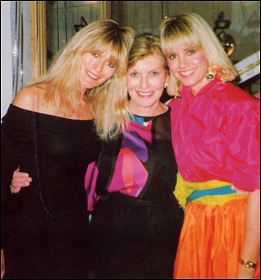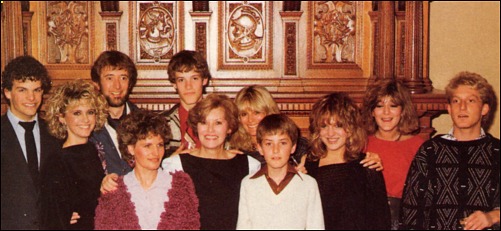Irene Newton-John (nee Born)
1914-2003
Irene Newton-John was born in 1914 in the west of Germany. She was the eldest daughter of Max Born who won the Nobel Prize in 1954 for Quantum Mechanics. Max was also a good friend of Albert Einstein and Irene remembers Einstein coming to their home and playing the violin. She would, in later life, translate letters exchanged between her father and Einstein. Irene came from a very academic family (see photo); her mother, Hedwig Ehrenberg, was a mathematician, her younger brother Gustav became a professor of pharmacology at London University and her sister Margaret was an artist and teacher who lived in Bath, England.
In the 1930s as Hitler was taking power, Professor Max Born, who was Jewish, fled Germany with his family and the British took them in. As a student Max Born had studied at Cambridge University in England so this is where the Born family settled. This all left a big impression on Irene and she kept a British passport throughout her life. When she became an Australian citizen in the early 80s she continued to carry a dual passport.
In 1937 Irene married Brinley Newton-John, a Welsh German professor who at the time was a student at Cambridge University. They had three children. Their first born Hugh went on to become a respected doctor in Melbourne, their second born Rona became a mother of four, actress and now works behind the scenes in the movie business. Their most famous offspring was singer Olivia Newton-John born in 1948. The first few years of marriage were difficult for Irene, as Brin was away a lot with the war. In fact Brin could only get home for Olivia’s birth and not for that of the elder children.
 Irene
and Brin left England in 1954 because Brin was offered a Dean at Ormond College part of
Melbourne University. Australia became their home and all the family settled there. Around
1959 Irene and Brin divorced. As with all divorces this was a traumatic time and Irene
found it difficult living alone in a small flat in Melbourne with the children. Irene had
to find work outside the home, as a public relations consultant, which was unusual in
Australia in those days . Irene was concerned most of all about her youngest child Olivia
because shortly after the divorce Hugh went to university and Rona got married. Olivia
became a "latch key" child.
Irene
and Brin left England in 1954 because Brin was offered a Dean at Ormond College part of
Melbourne University. Australia became their home and all the family settled there. Around
1959 Irene and Brin divorced. As with all divorces this was a traumatic time and Irene
found it difficult living alone in a small flat in Melbourne with the children. Irene had
to find work outside the home, as a public relations consultant, which was unusual in
Australia in those days . Irene was concerned most of all about her youngest child Olivia
because shortly after the divorce Hugh went to university and Rona got married. Olivia
became a "latch key" child.
Despite working long hours to make ends meet Irene kept a close eye on Olivia. She stopped her singing with her first group because her schoolwork was suffering and she was also concerned about Olivia becoming too involved with her first boyfriend, Ian Turpie. However, Irene had noticed Olivia’s singing abilities from an early age and allowed her to perform at a coffee house owned by her elder daughter’s husband. This led Olivia onto competitions, TV work and eventually to win a prize trip to England.
History shows that without Irene’s involvement, Olivia’s international career would almost certainly not have taken off. Left to her own devices Olivia would have stayed in Australia. Irene literally had to drag Olivia to England before the timescale for the prize trip ended. Olivia was only 16. Irene at the time said "I felt I had to take her to Europe so she’d get a proper sense of proportion because people here (Australia) tend to make too much of young stars. I felt she might have got a swollen head which would have ruined everything." Irene, being well-traveled herself, also knew that it was important to broaden her daughter's horizons.
Irene and Olivia moved to a tiny flat in London and Irene encouraged Olivia to pursue her dreams there. Olivia hated it and would try to book her flight back to Australia, but Irene would discover this and cancel it. Thankfully, another Australian singer, Pat Carroll, arrived from Australia and she and Olivia were able to work together. Irene left them to their own devices and shortly afterwards moved out of the flat they all shared.
Irene then began to explore her hobby of photography (click here for example) and found she had a flair for it. This led to a change of career and Irene was able to concentrate on this and writing on a freelance basis. Irene did not marry again, enjoying her own independence and freedom.
Irene also loved to travel and wrote travel columns for Australian magazines. In the early 80s she attended several lectures and ceremonies commemorating the 100th anniversary of her father’s birth (he died in 1970). As late as 2001 Irene flew to America to watch Olivia perform and visit her daughter Rona.
 Irene was also something of an activist. She campaigned
for the environment long before it was fashionable and was always conscious of saving
resources. She was very interested in architecture and campaigned for changes in
regulations to increase rights for house and flat buyers. She was also a keen swimmer
rising very early in the morning to keep herself healthy.
Irene was also something of an activist. She campaigned
for the environment long before it was fashionable and was always conscious of saving
resources. She was very interested in architecture and campaigned for changes in
regulations to increase rights for house and flat buyers. She was also a keen swimmer
rising very early in the morning to keep herself healthy.
Irene was also known for her discretion. Being the mother of a famous daughter led to hundreds of requests for interviews and quotes. Although Irene enjoyed Olivia’s success she rarely gave interviews and any given were first checked with Olivia.
She stayed close to all her children and relished the grandparent and great grandparent role (she had 8 grandchildren). Those of us, who didn't know her personally, will remember Irene as a remarkable woman: a loving mother with a strong, self-reliant streak and a deep sense of natural and social justice.